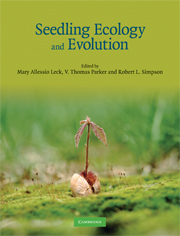Book contents
- Frontmatter
- Contents
- Contributors
- Foreword by Peter J. Grubb
- Preface
- Acknowledgments
- Part I Introduction
- Part II Seedling diversity
- Part III Seedling morphology, evolution, and physiology
- Part IV Life history implications
- Part V Applications
- Part VI Synthesis
- Chapter 18 The seedling in an ecological and evolutionary context
- References
- Index
Chapter 18 - The seedling in an ecological and evolutionary context
Published online by Cambridge University Press: 05 June 2012
- Frontmatter
- Contents
- Contributors
- Foreword by Peter J. Grubb
- Preface
- Acknowledgments
- Part I Introduction
- Part II Seedling diversity
- Part III Seedling morphology, evolution, and physiology
- Part IV Life history implications
- Part V Applications
- Part VI Synthesis
- Chapter 18 The seedling in an ecological and evolutionary context
- References
- Index
Summary
Introduction
All theories concerning metapopulation, source–sink, and metacommunity dynamics require dispersal, seed-bank dynamics, and seedling establishment to structure populations and communities (Hubbell, 2001; Leibold et al., 2004). Our understanding of dispersal (Howe & Smallwood, 1982; Nathan & Muller-Landau, 2000; Levine & Murrell, 2003), seed germination ecology (Baskin & Baskin, 1998; Fenner & Thompson, 2005), and seed-bank dynamics (Leck et al., 1989a), as well as the structure and dynamics of adult plants and communities, emphasize the need to bring the seedling life history stage to the fore. This is particularly important for the concept of recruitment limitation (Hurtt & Pacala, 1995).
Seedlings are clearly a vulnerable stage, shifting in short time periods from complete dependence on maternal reserves to physiological independence. Variation in seed size, carbon allocation patterns, and seedling structure and physiology has considerable influence on the potential for individual seedlings to survive to establishment. Dispersed across a variable habitat, mortality results from discordance in those characters and the environment, limiting potential establishment of seedlings. Their high mortality results from drought, herbivory, and disease (Moles & Westoby, 2006b; Fenner & Thompson, 2005; Kitajima, 2007), although many other factors also determine seedling success.
Reducing vulnerability may be accomplished by maternal investment in the seed that shepherds the seedling toward independence, or by facilitation by a nurse plant or other microhabitat (rock crack). Typically, the nurse plant is not the parent, raising the question of implications for community associations and long-term dynamics.
Information
- Type
- Chapter
- Information
- Seedling Ecology and Evolution , pp. 373 - 390Publisher: Cambridge University PressPrint publication year: 2008
Accessibility standard: Unknown
Why this information is here
This section outlines the accessibility features of this content - including support for screen readers, full keyboard navigation and high-contrast display options. This may not be relevant for you.Accessibility Information
- 6
- Cited by
